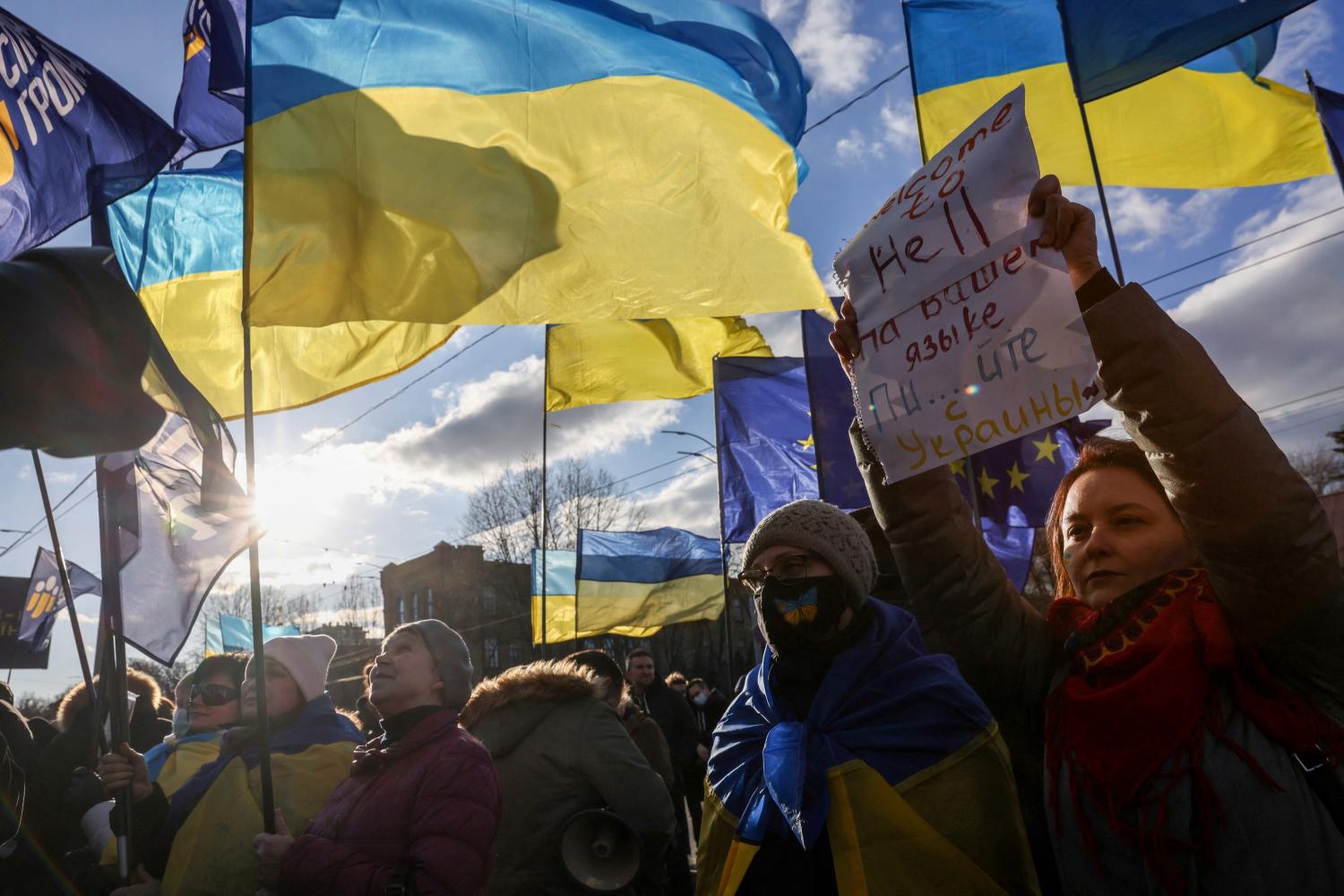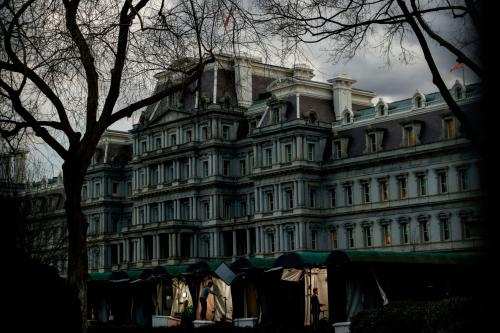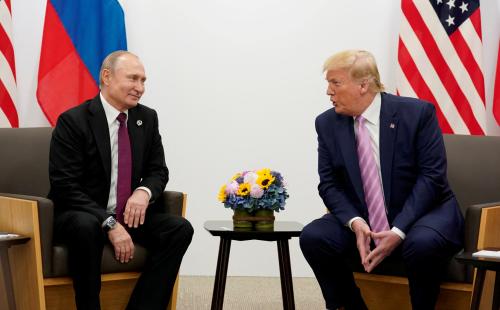This paper was written for a May 14 Center on the United States and Europe virtual workshop on “A new vision for European defense strategy?” as part of Brookings’s Reimagining Europe’s security project, along with Sophia Besch’s “How must Europe reorganize its conventional defense?” and Liviu Horovitz and Claudia Major’s “Should Europeans develop an independent nuclear deterrent?”
The Trump administration now acknowledges that it is unlikely to secure a ceasefire between Russia and Ukraine and an end to the war. It offered a deal that provided for:
- De facto acceptance of Russian possession of the lands it occupies in the Luhansk, Donetsk, Kherson, and Zaporizhzhia oblasts.
- U.S. de jure recognition of Russian sovereignty over Crimea.
- A promise that Ukraine will not join NATO.
- “Robust” European security guarantees for Ukraine.
- Provision for the reconstruction of Ukraine.
- The lifting of sanctions on Russia.
- Cooperation on energy and critical minerals between the United States and Ukraine.
While Moscow and Kyiv both have problems with this draft agreement, it is clear that Russia has profound objections, stemming from maximalist goals, that are likely insurmountable. In the Russia-Ukraine talks in Istanbul in early June, the Russians released a memo that demanded significant limitations on the size and composition of the Ukrainian military, an end to all Western military assistance to Ukraine, and a prohibition on European troops inside Ukraine, amongst other implausible asks. In effect, Russia wants a neutered Ukraine, not a neutral Ukraine.
The most likely result now is that the war continues for the rest of 2025 and quite possibly beyond. European allies of Ukraine therefore face two questions that are the subject of this paper:
- How can they help Ukraine defeat the Russian invasion and maximize the chances of an end to the war on terms that are acceptable to Ukraine?
- How can Europe help secure a sovereign and independent Ukraine and a durable peace after a ceasefire is reached?
Defeating Russian forces in Ukraine: Asymmetrical attrition in a stalemate
Let’s start with an inconvenient strategic reality: Ukraine will not be able to expel Russia from its territory in this war. Both sides have struggled to take territory since the fall of 2022, largely because of the persistent surveillance and lethality of drones, the effectiveness of tree line defenses, and landmines. The exceptions prove the rule. Ukraine took Kursk in August 2024 because the Russians were not there. Russia made some gains in late 2024, but less than expected and at an enormous cost. It is still possible to imagine Russia making significant gains if Ukraine faces a political and military crisis after a complete cessation of U.S. support, although even then it will be hard. It is very unlikely that Ukraine will be able to take back a lot of territory.
Therefore, Ukraine’s military objective in the war cannot be the expulsion of Russian forces from Ukraine because it is simply not achievable. An attainable goal is to change Moscow’s strategic calculus, so it is willing to accept a settlement to end the war on terms that are also acceptable to Kyiv. That settlement would not impose restrictions on the size of Ukraine’s military or on Western assistance.
The only plausible way of achieving this is what I call “asymmetrical attrition in a stalemate.” This means that Russia can only take small slivers of territory (basically a stalemate) at an enormous cost (asymmetrical attrition). Russia is suffering approximately 1,500 casualties a day and over 900,000 in total since the beginning of the war. Ukraine’s casualty rate is significantly lower, even weighting for its smaller population. If this rate of attrition continues, the war may be unsustainable for Russia without a wider mobilization, which Vladimir Putin does not want to do. In late March, Putin conscripted 160,000 people, the largest conscription since the beginning of the war, which was a sign of his manpower shortages.
To convince Russia that this is the likely alternative to a negotiation on acceptable terms to Kyiv, Ukraine needs to be able to fight a prolonged defensive war. It does not need to show that it can conduct a major offensive, although it should be ready to exploit real opportunities for small tactical advances if they present themselves. The key question is: Can Ukraine accomplish this without additional support from the United States?
First, the good news: Ukraine is not as reliant on the United States as it was in the first three years of the war. The Biden administration’s decision to surge weapons to it in the final months of the administration bought Ukraine time. The Biden administration also helped Ukraine crank up its own defense industrial base, producing vast quantities of attritable drones and other weapons. European nations are doing more to support Ukraine’s security—for example, the Czech Republic has played a leading role in providing 155mm munitions to Ukraine.
That said, although Ukraine will continue to fight, it will face critical shortages over time. Its casualty rate will rise, and Russia’s will likely fall. To address this, Europe needs a two-pronged strategy—what it will do itself and what it will ask of the Americans.
European allies should invest heavily in the Ukrainian defense industrial base so Kyiv can continue to produce an abundance of drones—this is the key weapon required for a strategy of asymmetrical attrition (as seen in the Spiderweb operation on June 1, 2025). They could also accept more risk in sending weapons from their own stockpiles to Ukraine and use their increased defense spending to replenish these over time. It is important to acknowledge, though, that some European governments may question whether this would come at the cost of urgently building up defenses along the NATO frontier. They may need these if the Trump administration pulls back further from the alliance and Putin launches a military operation designed to test Article 5 against NATO states in the next three and a half years.
Most importantly though, European leaders with traction with the White House, especially U.K. Prime Minister Keir Starmer and Italian Prime Minister Giorgia Meloni, should broker a compromise with Donald Trump whereby the United States provides the things that cannot be provided by others (either at all or in sufficient volume), as long as Russia is the primary obstacle to peace. This includes intelligence cooperation; air defenses, especially interceptors (e.g. AMRAAM air-to-air missiles and Patriot missiles); mid-range guided rockets (GMLRS); air-delivered weapons; anti-tank weapons; and armored vehicles.
Europe would pay the United States for the weapons and equipment, either out of its own funds or by tapping Russia’s sovereign assets. This would enable Trump to say he has significantly reduced U.S. support for Ukraine, he is not paying for the weapons the United States continues to provide, and the arms sales are designed to create the conditions for diplomacy to succeed. It is worth noting that securing a commitment to sell Ukraine weapons is not a foregone conclusion. Key figures in the Pentagon are likely to object to the sale of air defenses, GMLRS, and some other weapons because of readiness concerns, which is why European leaders will need to strike this deal with the president. An additional inducement for the United States could be an agreement with Ukraine on intellectual property (IP) and coproduction, whereby Ukraine gets older air defense and armor designs in exchange for the IP for its drones. This would be of significant strategic benefit to the United States and Ukraine.
Securing the peace: the “Israel Minus” model
If a peace deal is reached during the Trump administration, we know that it will not include U.S. security guarantees or a U.S. backstop for a European guarantee. The other viable model to secure a free and independent Ukraine is the so-called Israel model—the United States would lead an effort to provide Ukraine with military and intelligence assistance to enable it to defeat Russian forces without the direct intervention of the United States or other nations.
This approach takes its name from U.S. support for Israel, which is based on various memorandums of understanding that commit to providing Israeli forces with a “qualitative military edge.” In the case of Ukraine, the U.S. objective would be to provide it with a “credible defense and deterrence capability,” as it was termed in the 2024 U.S.-Ukraine Bilateral Security Agreement, meaning that it would be strong enough nationally to deter Russia from future aggression. In practice, this means Ukraine must:
- Be able to prevent Russia from taking terrain, particularly population centers.
- Be able to deny Russia access to lines of approach into Ukraine both on the ground and in the air, including with air defense.
- Be able to effectively destroy Russian combat power.
- Retain an offensive deep strike capability (such as longer-range ATACMS ballistic missiles and Taurus, SCALP, Storm Shadow, and JASSM cruise missiles) that will deter Moscow from launching a new war. This distinguishes this approach from a “porcupine strategy,” which implies a purely defensive capability with no capacity for long-range strike into Russia.
The problem with the Israel model is that the Trump administration is unlikely to continue to provide assistance to Ukraine through Presidential Drawdown Authority or the Ukraine Security Assistance Initiative, which have been the Biden administration’s two main mechanisms for doing so. It is unclear if the administration would sell Ukraine weapons through normal channels.
Europe can and should help Ukraine achieve a national deterrent without significant cooperation from the United States (call it “Israel Minus”). Israel Minus means that Europe would help Ukraine build a force of the future that would include a layered air defense, an air force (including a significant number of F-16 fighter jets with trained pilots), stockpiles of 155mm munitions and GMLRS, a trained force capable of combined arms operations, robust defenses along the line of control, long-range missiles, and a resilient and cutting-edge defense industrial base to produce as many weapons as possible in country. The allies could also promise to provide Ukraine with indirect support if it is attacked again along the lines of U.S. support for the past three years, except that there would be no restrictions on Ukrainian use of long-range weapons.
A coalition of European nations could also send in forces after a ceasefire to help train Ukrainian forces in country, advise on the future force’s structure, and help shape Ukraine’s strategic doctrine so it is capable of conducting combined arms operations. These forces would not be monitoring the line of control, nor would they be a tripwire force necessitating the European allies’ full-scale intervention if a new war breaks out. However, they would help strengthen Ukraine’s defenses, which makes the national deterrent stronger than it would otherwise be, and it would generate uncertainty in Moscow that a future conflict could be contained.
As in the case of helping the Ukrainians to defeat Russian forces in Ukraine, European nations will need to strike a deal to sell certain weapons and systems to Ukraine that cannot be provided by anyone else. This includes key components of a layered air defense as well as rockets. This should be negotiated alongside any ceasefire agreement between Ukraine and Russia.
Conclusion
The Trump administration’s position on Ukraine means that a just and lasting peace is not achievable in the short term. The best that we can hope for is a “good enough” solution that buys time, ensures Ukrainian sovereignty, and does not preclude revisiting these issues in the future under a different administration. Europe can do a lot to achieve a good enough solution, both for as long as the war continues and after a ceasefire. It will need to give weapons and equipment and cut some side deals with the United States on military sales, but the most important thing it can do is invest in Ukraine’s defense industrial base and its national capabilities.
The Brookings Institution is committed to quality, independence, and impact.
We are supported by a diverse array of funders. In line with our values and policies, each Brookings publication represents the sole views of its author(s).








